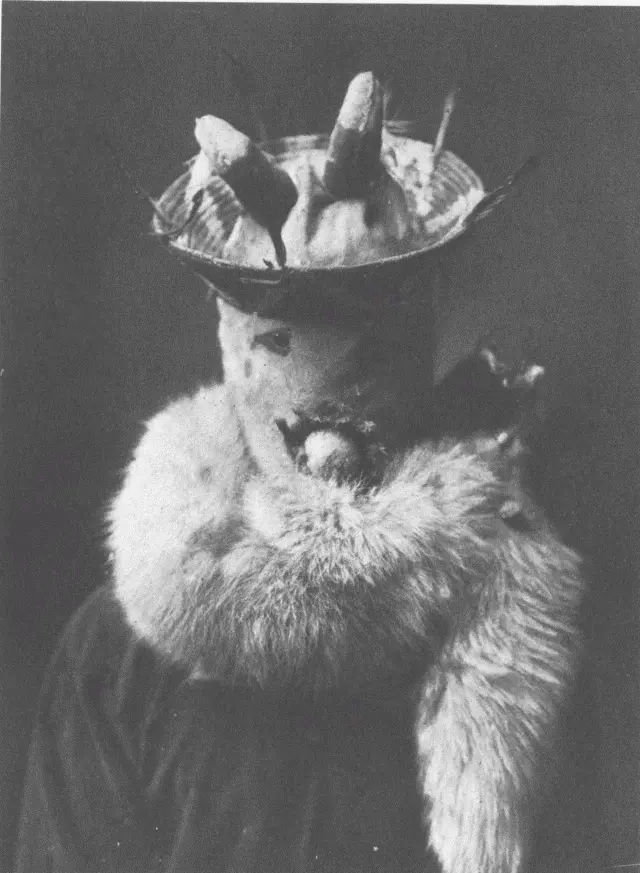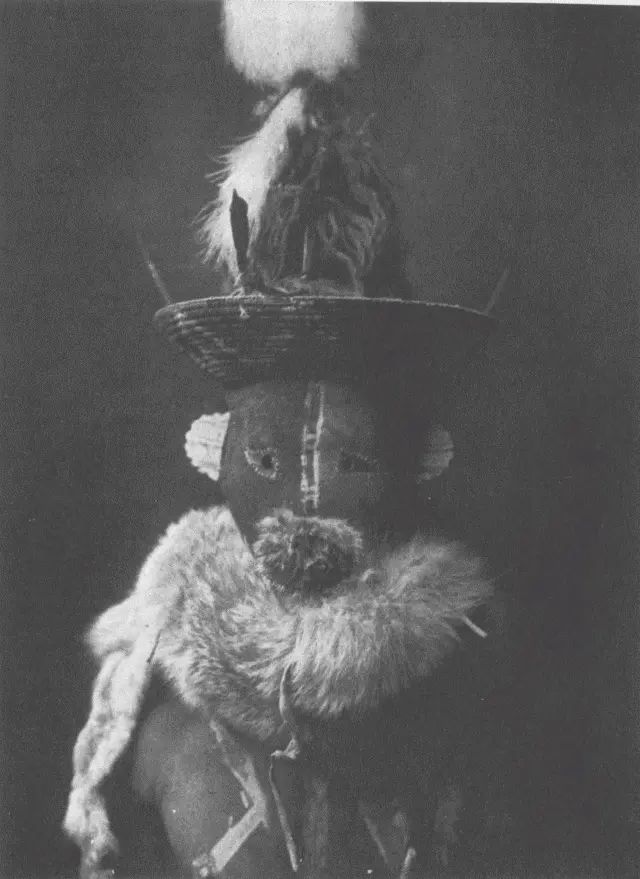Primitive Foods—See the list in the vocabulary.
Arts and Industries—The Navaho are known the world over for their skill in weaving. Practically every Navaho woman is a weaver, and the blanketry produced is one of the most important handicrafts of any tribe of North American Indians. A few baskets, of a single form, are made, and for ceremonial use only, most so-called Navaho ceremonial baskets being manufactured by neighboring tribes. The Navaho are also skilful silversmiths, having learned the art of metal-working from the Spaniards. Their first work of this character, however, was in iron, but this was superseded by the more easily worked silver. Some pottery is made, but it is rather crude in form, black in color, and without decoration.
Political Organization—The government of the Navaho is rather loose; indeed, inasmuch as they have no head-chief strictly such, it may be said that they have no tribal government. Their code of ethics and morals is governed almost entirely by their religious beliefs. There is always a man who is denominated the head-chief, but his influence is seldom much greater than that of any one of the many subordinate chiefs who are the recognized heads of small groups only.
Clans—Descent is reckoned through the mother, and a man and a woman belonging to the same clan may not marry. There are also related clans, forming phratries, within which marriage is also prohibited by tribal custom. In the Navaho creation myth it is related that four pairs of men and women were made by Yólkai Ĕstsán at her home beyond the western ocean, whence they migrated eastward, far inland, joining others of their kind created but a short time previously. Each parent pair was given a sacred jewel wand with which to bring water from the earth if no springs were found during the journey. The first man brought water with ease, remarking, "The water is close," owing to which circumstance he came to be termed To Ahánĭ, Water Is Close. In a similar way the other three pairs received the names of To Dĭchínĭ, Bitter Water; Hashklí̆shnĭ, Mud; and Kĭnya Ánĭ, Houses in the Cliffs. It required four days to make the journey from the ocean to what was to be their homeland. On the first day children were born to the several pairs; they matured by nightfall and camped apart from the parents as though they were not of kin, and received in turn a family name derived from their camp surroundings, from peculiarity of dress or form, or from remarks they made. These in turn bore children on the following day, who gave birth to others on the third. Thus were produced three new generations from each parent pair. All these then became clanship groups bearing names now applied to various Navaho clans. The four generations, including the original pairs, formed phratries, which have no names. The clans in each phratry in the order of generations are as follows:
To Ahánĭ - Water Is Close
Tzĭlh Klaánĭ - Mountain Corner
Tánĕ Zánĭ - Scattered Mounds
Hónĕ Gánĭ - Goes Around
To Dĭchínĭ - Bitter Water
Tsĭns Akánĭ - Under the Trees
Bin Bĕtónĭ - Deer Spring
To Dákoshĕ - Salty Water
Hashklí̆shnĭ - Mud
To Tsú̆hnĭ - Big Water
Bĭtánĭ - Folds her Arms
Hlúha Dĭné̆ - Reed People
Kí̆nya Ánĭ - Houses in the Cliffs
Bĕ Aánĭ - Fallen Leaves
Tzĭlh Tad - In Front of the Mountains
Kí̆nya Ánĭ - (An inferior clan of the same name as the first of this group)
Cliff people already occupying the country formed three clans: Tsĕnĭjĭkĭnné̆, In the Rock Houses; To Hĕt Klí̆nĭ, Where the Waters Come Together; and Tzĭlhnúhodĭnlĭ, Beside the Mountain. An old woman joined the Navaho from the salt lakes to the south, heading the Ashĭhín clan. People from Jemez formed the Mai Dĕshkís, or Coyote Pass, clan; Apache from the Cibicu cañon, the Dĕschínĭ clan, or Red-light People, and families from Zuñi the Nashtĕzhé̆, Blackened Eyebrows, clan, and Tŭh'chínĭ, Red Heads, clan, so called from their painted faces and bodies. There are numerous other clanship groups derived from adopted peoples now recognized as being distinctly Navaho; the first sixteen clans here named are accepted in the tribe as being strictly Navaho in origin.
Marriage—The girl's consent is necessary to marriage, but tribal custom demands that the intended husband compensate her parents, the usual price being fourteen horses and a silver belt. Indeed, the bringing of the horses is a part of the ceremony. When a young man desires to marry, but does not have the necessary number of horses, his friends aid him by presenting horses until he has the required number. The marriage ceremony takes place at night under the direction of a medicine-man.

Ganaskĭdĭ - Navaho
Origin—Mythical First People produced from corn, rain, pollen, and precious stones in a miraculous manner by four gods and the Winds.
Persons of Miraculous Birth—Nayé̆nĕzganĭ and Tobadzĭschí̆nĭ are the sons of the Sun and Water respectively, and the virgin Yólkai Ĕstsán, White-Shell Woman. Man-destroying monsters, symbolic of earthly evils, infested the earth until destroyed by these two miraculous personages.
Ceremonies—The Navaho life is particularly rich in ceremony and ritual, second only to some of the Pueblo groups. Note is made of nine of their great nine-day ceremonies for the treatment of ills, mental and physical. There are also many less important ceremonies occupying four days, two days, and one day in their performance. In these ceremonies many dry-paintings, or "sand altars," are made, depicting the characters and incidents of myths. Almost every act of their life—the building of the hogán, the planting of crops, etc.—is ceremonial in nature, each being attended with songs and prayers.
Burial—The Navaho dead are buried by others than immediate relatives in unmarked graves. No ceremonies are held, for the dead are considered evil and are feared. The hogán in which death occurs is forever abandoned, often burned. Sometimes a hogán is demolished over the dead and then left to decay.
After-world—An under-world whence came the spirit people who created man and to which spirits return.
Names for Indian Tribes—
Acoma - Háqonĭ (An Acoma word)
Apache - Tzlĭh A Gón (On the Mountains)
Chiricahua - Klí̆shnĭ (Red War-paint)
Cochiti - To Gad (Cedar Water)
Comanche - Aná Tlú̆nĭ (Many Enemies)
Havasupaí - Gohní̆nĭ (A term borrowed from the Hopi)
Hopi - Ayá Kĭnné̆ (Hole Houses)
Isleta - Aná To Ho (Tribe by the Water)
Jemez - Mai Dĕshkís (Coyote Pass)
Laguna - To Tlú̆nĭ (Have much Water)
Mohave, Pima, Maricopa, Yuma, Papago - Bĕ Ĕsá Ntsái (With large Jars)
Navaho - Dĭné̆
Sandia - Kĭn Nodózĭ (Striped Houses)
San Felipe - To Háchĕle (Pull up Water)
San Ildefonso - Tsĕ Tŭ Kĭnné̆ (Houses between Rocks)
San Juan - Kĭn Klĕchínĭ (Red-house People)
Santa Clara - Ána Sú̆shĭ (Tribe like Bears—from skunkskin moccasins, first thought to be of bearskin)
Santo Domingo - Kĭn Klĕkái Nĭ (White Houses)
Sia - Tlógĭ (Hairy)
Taos - To Wolh (Water Gurgles)
Zuñi - Nashtĕzhé̆ (Blackened Eyebrows)
Southern Athapascan Comparative Vocabulary
Table of Contents
| Anatomical Terms |
| English |
Apache |
Jicarilla |
Navaho |
| ankle-joint |
ko-ká̆ ĭlh-rŭ-nŭ-ni-wú |
ké̆t-sin |
a-ké̆ts-in |
| arm |
ko-gún |
gŏn |
a-gán |
| blood |
dĭlh |
tí̆l-thĕ |
dĭlh |
| bone |
its-í̆n |
í̆ts-ĭn |
ts'ĭn |
| chest |
i-tí̆l |
ko-yé̆-tĕ |
a-jĕ-í̆ts-in |
| chin |
ko-yé̆-dâ |
ĭs-é̆-tâ |
á̆-yăts-in |
| ear |
id-já |
ĭd-já |
ă-já |
| elbow |
ko-gún ĭlh-rŭ-nŭ-ni-wú |
ĭd-an-hlá |
osh-lé |
| eye |
in-dá̆ |
ĭt-á |
ăn-án |
| face |
ko-ní |
ĭn-ní |
ăn-ín |
| finger |
ko-lụ-zhúzh |
in-lấ |
shĭ-lă |
| finger-nail |
ko-lụ-gún |
in-lâ-gó̆n |
shĭ-lá̆sh-gân |
| foot |
ko-ké̆ |
i-ká |
kĕ |
| hair |
tsĭ-rấ |
ĭt-sé̆ |
tsi-ghá̆ |
| hand |
ko-gún |
u-lá |
shí-lă |
| head |
kots-its-í̆n |
í̆ts-ĭts-ĭn |
sí̆ts-ĭts-in |
| heart |
kod-jí did-jú-la |
ko-chá |
a-je-id-í̆sh-jalh |
| knee |
ko-qút |
ĭ-kó |
ă-whód |
| leg |
kod-jấk |
ĭ-jấd |
ă-jấd |
| lip |
su-sŭ-bâ-né̆ |
ĭ-tấ |
ă-dấ |
| lungs |
kod-jí |
ĭ-tâ-lé̆ |
a-jé |
| mouth |
ko-zá |
ĭ-zé̆ |
si-zé |
| neck |
ko-gús |
ĭ-kó̆s |
ăk-ás |
| nose |
ko-chí |
ĭ-chín |
ă-chí̆n |
| nostril |
kó-ní̆ |
ĭn-né̆ |
ă-ní̆n |
| shoulder |
ko-hwás |
ĭh-hwás |
ă-hwás |
| toe |
ko-kĕ-zhúzh |
ĭh-ké̆sh |
a-ké̆ |
| toe-nail |
ko-kĕ-gún |
ĭh-ké̆sh-gŏn |
a-ké̆sh-gân |
| tongue |
kŏ-zá |
ĭh-zá-tĕ |
a-tsó |
| tooth |
ko-wú |
ĭh-gwó |
a-hwó |
| Animals (See also Foods) |
| English |
Apache |
Jicarilla |
Navaho |
| antelope |
já-gĕ |
tá-ga-tĕ |
jú̆-dĭ |
| badger |
bụ-ntă-lé̆ na-gans-chi-tn |
ná-as-chĭd |
|
| bat |
cha-bâ-né̆ |
cha-na-mi-ín |
jâ-a-bá-nĭ |
| bear |
sŭsh |
shash |
sŭsh |
| beaver |
cha |
cha |
cha |
| blue-bird |
rụsh-tá du-tlí̆sh |
dó-lo |
dó-lĭ |
| buffalo |
bĭ-shĭsh-jík |
ă-yán-dĕ |
a-yá-nĭ |
| buzzard |
chi-shó-gĭ |
ta-chá-ze |
jé-sho |
| chipmunk |
gụ-sụs-sí |
ĭn-se-zú-so |
tsĭd-í̆t-í̆-nĭ |
| coyote |
ban |
tsil-i-té̆n |
mai |
| crow |
gấ-gĕ |
kấ-gĕ |
gấ-gĕ |
| deer |
bin |
bin |
bin |
| eagle |
tsá-cho |
i-tsá |
a-tsá |
| elk |
bin-nal-dé̆ |
tzĕs |
tzĕ |
| gopher |
na-ilh-tlí-gi |
ma-í-nĕ-lin |
na-a-zí-si |
| hawk |
ĭt-sấ |
ĭt-sé̆-so-yĕ g'í̆-ni |
|
| mountain lion |
ndú-chú |
ĕn-tó-yĕ |
nash-tu-í-tso |
| mountain sheep |
dĕ-bé̆-chụ zi-dĕ-bé̆ |
tsĕ-tú̆-dĕ-bĕ |
|
| owl |
bụ |
yí-yĕ |
nás-cha |
| rat (wood) |
klósh-chụ |
klé̆-tso |
klĕ-é̆-tso |
| skunk |
gụ-lízh-ĭ |
kĕl-din-shé̆n wo-lí̆-zhi |
|
| spider |
na-alht-lo-lé̆ |
mans-ché̆ |
nash-jé'i |
| squirrel |
tsĕ-skús-si |
na-jĭl-kái-ĭ |
t'lá-zi |
| turkey |
tá-zhĭ |
ká-zhĭ |
tá-zhĭ |
| wolf |
ban-chú |
bai-é̆-tso |
mai-í̆-tso |

Zahadolzhá - Navaho
Читать дальше














